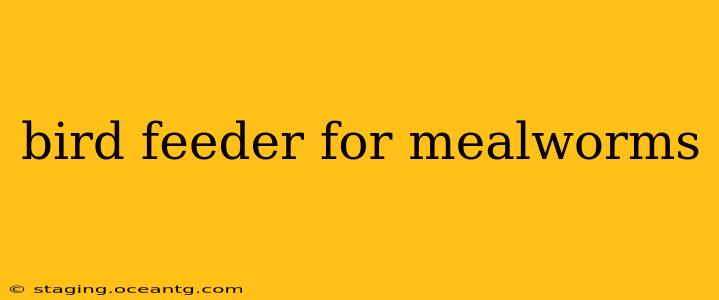Mealworms, the larval stage of the darkling beetle ( Tenebrio molitor), are a fantastic source of protein and fat for many bird species, particularly insectivores and young birds. However, simply scattering mealworms on the ground isn't the most effective method. A dedicated bird feeder designed for mealworms ensures the birds get easy access to this nutritious treat while minimizing waste and attracting unwanted pests. This guide explores the best options for bird feeders optimized for mealworms and answers common questions.
What's the Best Type of Bird Feeder for Mealworms?
The ideal feeder for mealworms prevents them from scattering or becoming contaminated. Several types work well:
-
Suet feeders: Many suet feeders have cages or compartments that hold soft foods like mealworms securely. The mesh prevents larger birds from grabbing the entire feeder and helps keep the mealworms fresh. Look for feeders with smaller mesh sizes.
-
Platform feeders: A simple, shallow platform feeder works if you don't mind a little mess. However, it's essential to clean it frequently to prevent mold and bacteria. To prevent the mealworms from being blown away or scattered by larger birds, you could consider a covered platform feeder.
-
Specialized mealworm feeders: While not as common, some manufacturers create feeders specifically designed for mealworms. These usually incorporate features to minimize waste and keep the mealworms accessible to the birds while deterring other animals.
-
DIY options: You can easily create a mealworm feeder using simple materials like a small container, mesh, and a hook. Just ensure the container is appropriately sized and secured to avoid spills and contamination.
Avoid using feeders with narrow openings or intricate designs, as these can prevent smaller birds from accessing the mealworms.
How Often Should I Refill a Mealworm Feeder?
The frequency of refilling depends on the number of birds visiting your feeder and the quantity of mealworms you provide. As a general guideline, check your feeder daily, especially during peak feeding times (mornings and evenings). If the mealworms are mostly consumed, refill it immediately. If a significant portion remains, you can refill every other day or as needed. Remember to remove any spoiled or uneaten mealworms to prevent attracting unwanted pests or creating a breeding ground for bacteria.
What Kind of Mealworms Should I Use in a Bird Feeder?
While live mealworms are generally preferred by birds, dried mealworms are also a viable option. Live mealworms offer a more stimulating foraging experience for the birds, while dried mealworms are more convenient and have a longer shelf life. Regardless of whether you use live or dried mealworms, ensure they are high-quality, free from contaminants, and stored properly to maintain their nutritional value.
Can I Put Other Foods in a Mealworm Feeder?
While mealworms are the star of the show, you can combine them with other foods, such as suet or fruits. However, avoid mixing them with watery substances, as this can cause the mealworms to spoil more quickly. Keep in mind that adding other foods may attract a broader range of birds and potentially increase the risk of competition.
How Do I Clean a Mealworm Feeder?
Cleaning your mealworm feeder regularly is crucial to prevent the spread of disease and maintain a healthy environment for the birds. Wash the feeder thoroughly with warm soapy water once a week, or more frequently if needed. Rinse it well and allow it to dry completely before refilling it with mealworms. You can also use a mild disinfectant solution if necessary, but be sure to rinse it thoroughly afterwards to avoid harming the birds.
Are there any disadvantages to using mealworm feeders?
Yes, there are a few potential drawbacks to using mealworm feeders:
-
Attracting unwanted pests: Mealworms can attract rodents and other unwanted pests if not managed correctly. Regular cleaning and appropriate storage are essential to mitigate this risk.
-
Cost: Live mealworms can be more expensive than other birdseed options. Consider supplementing with other feed types to reduce costs.
-
Mess: Some mealworm feeders can be messier than other feeder types. Choose a feeder that minimizes mess and consider placing it on a surface that's easy to clean.
By following these guidelines and selecting the appropriate feeder for your needs, you can provide your feathered friends with a delicious and nutritious mealworm treat while maintaining a clean and healthy feeding environment. Remember, responsible bird feeding practices are key to ensuring the well-being of both your birds and the environment.
